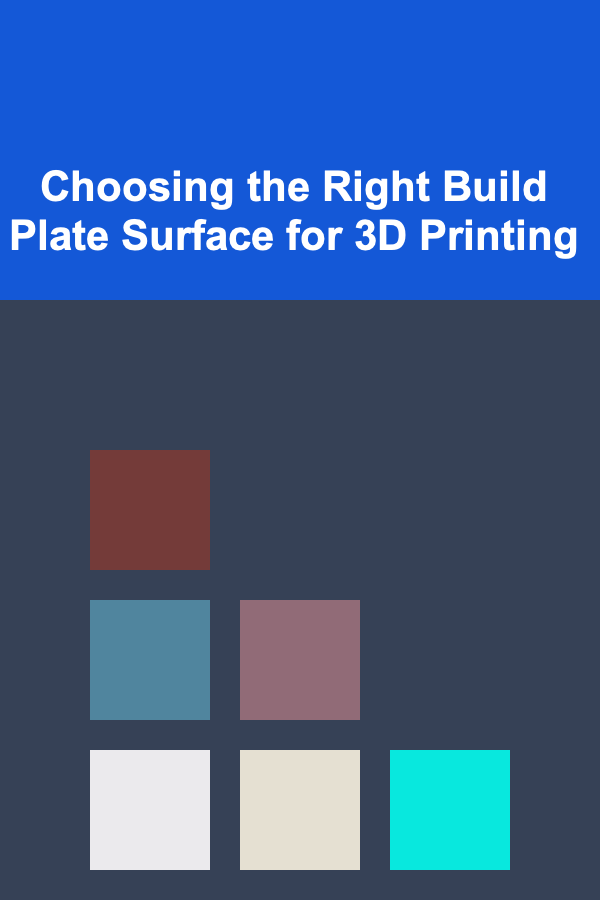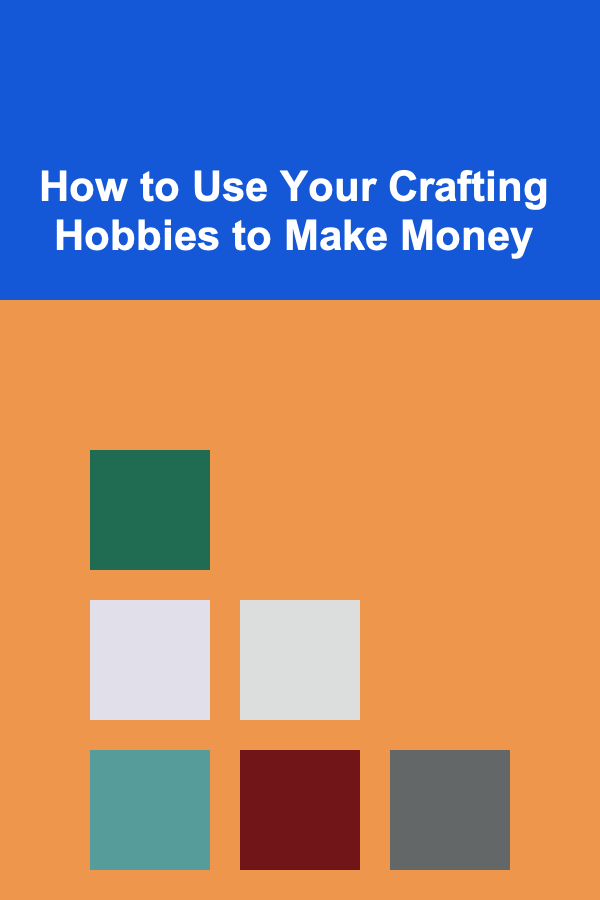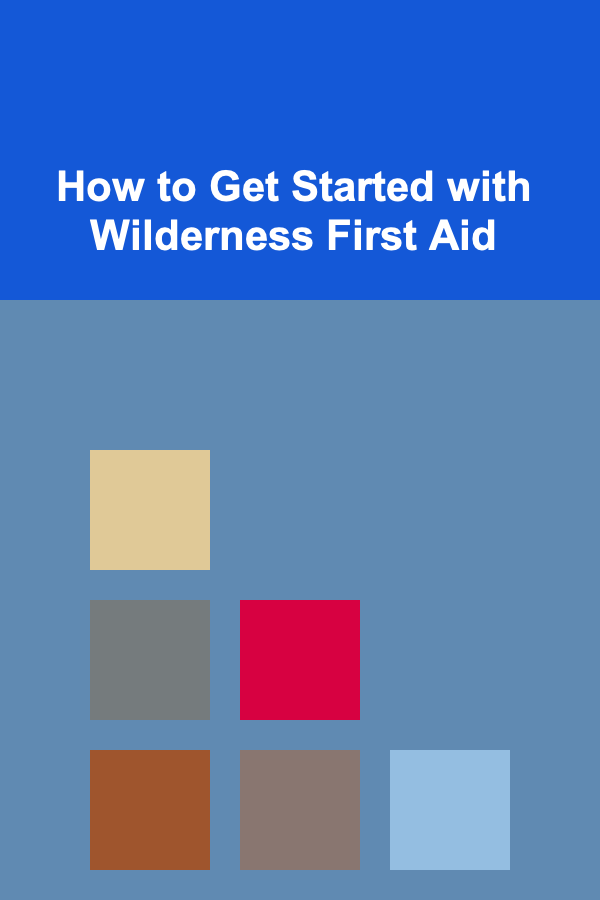
Choosing the Right Build Plate Surface for 3D Printing
ebook include PDF & Audio bundle (Micro Guide)
$12.99$9.99
Limited Time Offer! Order within the next:

The build plate surface is a critical, yet often overlooked, component in the 3D printing process. It's the foundation upon which your 3D prints are built, directly impacting adhesion, warping, print quality, and even the lifespan of your printer. Selecting the appropriate surface can drastically improve your printing success rate and the overall quality of your finished parts. This article delves into the various types of build plate surfaces available, their pros and cons, and how to choose the optimal surface for your specific printing needs.
Understanding the Importance of Build Plate Adhesion
Before diving into the different surface types, it's essential to understand why build plate adhesion is so important. Poor adhesion leads to a multitude of problems, including:
- Warping: Corners and edges of the print lifting off the build plate, causing dimensional inaccuracies and potentially ruining the print. This is particularly common with materials like ABS and nylon, which have higher shrinkage rates.
- Print Failure: The print detaching completely from the build plate during printing, resulting in a tangled mess of filament.
- Poor First Layer: A poorly adhered first layer can lead to a rough or uneven base, which can affect the overall appearance and functionality of the print.
- Elephant's Foot: An excessive squishing of the first layer, caused by the nozzle being too close to the build plate or insufficient cooling, leading to a wider-than-intended base.
Good build plate adhesion ensures that the first layer is firmly attached to the surface, providing a stable foundation for the rest of the print. This is crucial for achieving accurate dimensions, minimizing warping, and ensuring successful print completion. The ideal adhesion strikes a balance: strong enough to hold the print in place during printing, but easy enough to remove the finished print without damaging it or the build plate.
Factors Influencing Build Plate Adhesion
Several factors influence build plate adhesion, and selecting the right surface is just one piece of the puzzle. Other important factors include:
Build Plate Temperature
Heating the build plate significantly improves adhesion, especially for materials like ABS and nylon. The heated bed helps to keep the first layer warm, reducing the risk of warping caused by rapid cooling and shrinkage. Each filament has an optimal build plate temperature, so consulting the manufacturer's recommendations is crucial. Common temperature ranges include:
- PLA: 20-60°C (68-140°F)
- ABS: 80-110°C (176-230°F)
- PETG: 60-80°C (140-176°F)
- Nylon: 70-100°C (158-212°F)
Nozzle Distance (Z-Offset)
The distance between the nozzle and the build plate during the first layer is critical. If the nozzle is too far away, the filament won't properly adhere to the surface. If the nozzle is too close, it can squish the filament excessively, leading to an "elephant's foot" effect or even clogging. Properly calibrating the Z-offset is essential for achieving optimal first-layer adhesion.
First Layer Speed
Printing the first layer at a slower speed allows the filament more time to bond to the build plate. A slower speed also allows for more precise placement of the filament, reducing the risk of gaps or overlaps. A common starting point is to reduce the first layer speed to 50% of the standard printing speed.
Build Plate Leveling
A level build plate is fundamental for consistent adhesion across the entire printing surface. If the build plate is not level, some areas may be too close to the nozzle while others are too far away, leading to inconsistent adhesion. Many printers have auto-leveling features, but manual leveling is still often necessary for optimal results.
Ambient Temperature and Drafts
The ambient temperature and presence of drafts can affect the cooling rate of the print, especially during the first few layers. Drafts can cause uneven cooling, leading to warping. Enclosing the printer can help to maintain a more consistent temperature and reduce the impact of drafts, particularly for materials like ABS.
Types of Build Plate Surfaces: A Comprehensive Overview
Here's a detailed look at some of the most common types of build plate surfaces, including their advantages, disadvantages, and best use cases:
Glass
Glass is a popular and versatile build plate surface. It offers a smooth, flat surface for printing and is relatively inexpensive. Borosilicate glass is commonly used due to its resistance to thermal shock. Adhesion can be enhanced by applying adhesives like glue stick or hairspray.
Pros:
- Smooth Surface: Produces a very smooth bottom layer, which can be desirable for aesthetic purposes.
- Relatively Inexpensive: Glass is a cost-effective material.
- Durable: Borosilicate glass is resistant to thermal shock and can withstand repeated heating and cooling cycles.
- Easy to Clean: Can be easily cleaned with isopropyl alcohol.
- Can be used with adhesives: Works well with glue stick, hairspray, or specialized 3D printing adhesives to improve adhesion.
Cons:
- Requires Adhesives: Often requires adhesives for good adhesion, especially with materials like ABS.
- Can be Brittle: Can crack or break if subjected to excessive force or sudden temperature changes.
- Slow to Heat Up: Glass takes longer to heat up compared to some other materials.
- Print Removal can be Difficult: Prints can sometimes be difficult to remove, especially if they are strongly adhered.
Best Used For:
PLA, PETG, with adhesives. Can also be used for ABS with appropriate adhesives and printer enclosure. Good for achieving a smooth bottom surface.
PEI (Polyetherimide)
PEI is a thin, flexible plastic sheet that provides excellent adhesion for a wide range of materials. It's known for its ease of use and durability. PEI sheets are typically applied to a metal build plate with an adhesive backing.
Pros:
- Excellent Adhesion: Provides excellent adhesion for PLA, PETG, ABS, and even some more challenging materials like TPU.
- Easy to Use: Easy to install and maintain.
- Durable: Relatively durable and can withstand repeated use.
- No Adhesives Needed (Generally): Often doesn't require the use of adhesives, although they can be used for very challenging materials.
- Easy Print Removal: Prints generally release easily once the build plate cools down.
Cons:
- Can be Scratched: Can be scratched by sharp objects or aggressive print removal techniques.
- Can be Damaged by High Temperatures: Excessive temperatures can degrade the PEI surface over time.
- Can be Difficult to Remove Prints (Sometimes): Some materials, like PETG, can adhere too strongly and damage the surface during removal if not cooled sufficiently.
- Air Bubbles During Application: Can be difficult to apply without trapping air bubbles.
Best Used For:
PLA, PETG, ABS, TPU. A good all-around surface for a variety of materials.
PEO (Polyetheretherketone)
PEO is a high-performance thermoplastic polymer that offers a glossy or textured finish to the bottom of prints, depending on the specific sheet type. It is known for excellent chemical resistance and high temperature resistance.
Pros:
- Aesthetic Finish: Produces visually appealing bottom surfaces, often with a glossy or slightly textured appearance, depending on the sheet.
- Good Adhesion: Provides reliable adhesion for many materials, similar to PEI.
- Durable and Heat Resistant: PEO is very chemically and heat resistant.
- Easy Print Removal: Prints typically release easily upon cooling.
Cons:
- Price: Typically more expensive than PEI or glass.
- Can Be Damaged by Aggressive Removal: Even though prints release easily, using excessive force can still damage the surface.
- Fewer Varieties: Fewer texture and finish options available compared to PEI.
Best Used For:
PLA, PETG, ABS. Ideal when a specific aesthetic finish on the bottom of the print is desired.
Powder-Coated PEI
Powder-coated PEI offers a textured surface that provides excellent adhesion and a unique finish to the bottom of prints. The textured surface also makes it more resistant to scratches and damage compared to smooth PEI.
Pros:
- Excellent Adhesion: Provides even better adhesion than smooth PEI, especially for materials like PETG and TPU.
- Durable: More resistant to scratches and damage compared to smooth PEI.
- Textured Finish: Produces a textured finish on the bottom of prints, which can be desirable for certain applications.
- Easy Print Removal: Prints generally release easily once the build plate cools down.
Cons:
- Textured Finish: The textured finish may not be desirable for all applications.
- Can be More Difficult to Clean: The textured surface can make it slightly more difficult to clean compared to smooth surfaces.
Best Used For:
PETG, TPU, ABS, Nylon. A good choice for materials that tend to over-adhere to smooth surfaces, or when a textured bottom finish is desired.
BuildTak
BuildTak is a proprietary build surface material that is designed to provide excellent adhesion for a wide range of filaments. It's a thin sheet that adheres to the build plate.
Pros:
- Excellent Adhesion: Provides excellent adhesion for a wide range of filaments, including PLA, ABS, PETG, and TPU.
- Durable: Resistant to wear and tear.
- Easy to Use: Easy to install and maintain.
Cons:
- Print Removal can be Difficult: Prints can sometimes be difficult to remove, especially if they are strongly adhered. This can potentially damage the surface.
- Can Leave a Textured Finish: Can leave a textured finish on the bottom of prints.
- Can be Relatively Expensive: More expensive than some other options.
Best Used For:
PLA, ABS, PETG, TPU. A good option for printers where consistent adhesion is a primary concern.
Kapton Tape
Kapton tape is a heat-resistant polyimide film that can be applied to the build plate to improve adhesion, particularly for ABS. It provides a consistent and relatively smooth surface.
Pros:
- Good Adhesion for ABS: Provides decent adhesion for ABS, especially when the build plate is heated.
- Heat Resistant: Withstands high temperatures without degrading.
- Relatively Inexpensive: Kapton tape is a cost-effective solution.
Cons:
- Difficult to Apply Smoothly: Can be challenging to apply without air bubbles or wrinkles, which can affect print quality.
- Requires Replacement: Needs to be replaced frequently as it wears down or becomes damaged.
- Not Ideal for PLA: Doesn't provide the best adhesion for PLA compared to other surfaces.
Best Used For:
ABS. A budget-friendly option for ABS printing, but requires careful application and frequent replacement.
Blue Painter's Tape
Blue painter's tape is a common and inexpensive option, primarily used for printing PLA. It provides a slightly textured surface that helps PLA adhere.
Pros:
- Inexpensive: A very cheap and readily available option.
- Good Adhesion for PLA: Provides good adhesion for PLA.
- Easy to Replace: Easy to apply and replace as needed.
Cons:
- Not Suitable for High-Temperature Filaments: Not suitable for ABS, PETG, or other high-temperature filaments.
- Requires Frequent Replacement: Wears down quickly and needs frequent replacement.
- Can Leave a Textured Finish: Leaves a textured finish on the bottom of prints.
Best Used For:
PLA. A simple and inexpensive solution for PLA printing, but not suitable for other materials.
Garolite/FR4
Garolite, also known as FR4, is a composite material made of fiberglass cloth and epoxy resin. It's known for its excellent strength, heat resistance, and electrical insulation properties. It's gaining popularity as a build plate surface due to its excellent adhesion for various materials.
Pros:
- Excellent Adhesion: Provides excellent adhesion for a wide range of materials, including PLA, PETG, ABS, and Nylon.
- Durable: Very durable and resistant to wear and tear.
- Heat Resistant: Can withstand high temperatures without degrading.
- Consistent Performance: Offers consistent adhesion performance over time.
Cons:
- Can Be Difficult to Find: May be less readily available than some other build surface options.
- Can Require Specific Cleaning: May require specific cleaning methods to maintain adhesion.
- Can Warp if not Properly Supported: Thinner sheets may warp if not properly supported.
Best Used For:
PLA, PETG, ABS, Nylon. A good all-around surface that provides excellent adhesion and durability.
Choosing the Right Surface: A Decision Guide
Selecting the right build plate surface depends on several factors, including the materials you plan to print, your budget, and your desired print finish. Here's a guide to help you make the best choice:
For PLA
PLA is the easiest material to print and adheres well to a variety of surfaces. Recommended options include:
- PEI: A great all-around choice, offering good adhesion and ease of use.
- Blue Painter's Tape: A budget-friendly option, especially for beginners.
- Glass with Glue Stick: Provides a smooth bottom surface.
- PEO: If you want a glossy or textured bottom surface.
- Garolite/FR4: Provides excellent adhesion and durability.
For ABS
ABS is more challenging to print than PLA and requires a heated build plate and good adhesion to prevent warping. Recommended options include:
- PEI: Can work well with ABS, especially with an enclosed printer and heated bed.
- Powder-Coated PEI: Excellent adhesion, particularly with an enclosed printer.
- Glass with ABS Slurry or Kapton Tape: Requires more preparation but can provide reliable adhesion. Use with an enclosure for best results.
- Garolite/FR4: Offers excellent adhesion and durability, even for ABS. An enclosure is still recommended for larger prints.
For PETG
PETG can be prone to over-adhesion, making it difficult to remove prints without damaging the surface. Recommended options include:
- Powder-Coated PEI: The textured surface prevents over-adhesion and makes removal easier.
- PEI (with Release Agent): Using a thin layer of glue stick as a release agent can help prevent over-adhesion.
- Glass with Hair Spray: Provides good adhesion without being too strong.
- PEO: Provides good adhesion, prints should be easily removed.
- Garolite/FR4: Provides excellent adhesion, but proper cooling is necessary for easy removal.
For TPU (Flexible Filaments)
TPU can also over-adhere to some surfaces. Recommended options include:
- Powder-Coated PEI: The textured surface provides excellent adhesion without being too strong.
- PEI (with Release Agent): Similar to PETG, a release agent can help.
For Nylon
Nylon requires a high-temperature build plate and excellent adhesion. Recommended options include:
- Garolite/FR4: One of the best choices for Nylon, providing reliable adhesion.
- PEI with Specialized Nylon Adhesive: Some specialized adhesives are designed to improve Nylon adhesion to PEI. An enclosure is vital to control warping.
Budget Considerations
- Low Budget: Blue painter's tape for PLA, glass with glue stick.
- Mid-Range Budget: PEI sheet, BuildTak.
- High Budget: Powder-coated PEI, Garolite/FR4, PEO.
Desired Print Finish
- Smooth Bottom Surface: Glass with adhesives, smooth PEI.
- Textured Bottom Surface: Powder-coated PEI, blue painter's tape, PEO (depending on the sheet).
- Glossy Bottom Surface: PEO.
Tips for Maintaining Your Build Plate Surface
Proper maintenance is essential for maximizing the lifespan and performance of your build plate surface. Here are some tips:
- Regular Cleaning: Clean the build plate regularly with isopropyl alcohol to remove grease, fingerprints, and residue from previous prints.
- Avoid Touching the Surface: Avoid touching the build surface with your bare hands, as oils from your skin can affect adhesion.
- Use a Scraper Carefully: Use a scraper to remove prints carefully, avoiding excessive force that could damage the surface. Consider using a flexible scraper.
- Level the Build Plate Regularly: Ensure the build plate is properly leveled to prevent uneven adhesion.
- Replace Worn Surfaces: Replace build plate surfaces when they become worn or damaged to maintain optimal adhesion.
- Use the Right Adhesives (Sparingly): If using adhesives, apply them sparingly and evenly. Remove any excess adhesive after each print.
- Proper Storage: Store removable build plates flat and in a clean environment to prevent warping or damage.
Conclusion
Choosing the right build plate surface is a critical step in achieving successful and high-quality 3D prints. By understanding the different types of surfaces available, their pros and cons, and the factors that influence build plate adhesion, you can make informed decisions that optimize your printing workflow and improve your results. Experimentation is key; try different surfaces and techniques to find what works best for your specific printer, materials, and printing needs. Remember that factors beyond the surface itself, such as temperature, leveling, and printing speed, all contribute significantly to overall print quality and adhesion. With careful consideration and proper maintenance, you can ensure that your build plate surface provides a solid foundation for all your 3D printing projects.

How to Create a Mood Board for Your Staging Project
Read More
How to Find and Book Conference Speakers: A Checklist for Success
Read More
How to Implement a Neighborhood Watch Program for Better Security
Read More
How to Make a Checklist for Organizing Your Interview Day
Read More
How to Use Your Crafting Hobbies to Make Money
Read More
How to Get Started with Wilderness First Aid
Read MoreOther Products

How to Create a Mood Board for Your Staging Project
Read More
How to Find and Book Conference Speakers: A Checklist for Success
Read More
How to Implement a Neighborhood Watch Program for Better Security
Read More
How to Make a Checklist for Organizing Your Interview Day
Read More
How to Use Your Crafting Hobbies to Make Money
Read More